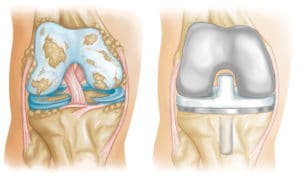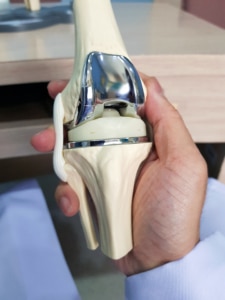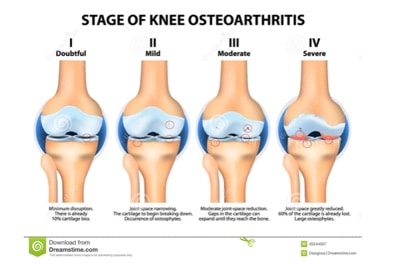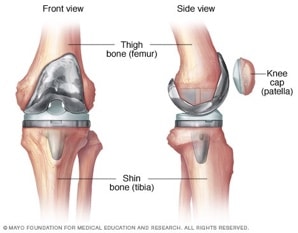Discover Your Pinehurst Knee Replacement Surgery Options

Read What Our Patients Are Saying:
“He performed bilateral knee replacement surgery on me. Excellent doctor! Great bedside manners! Highly recommended!” -Ernestine G
“Dr Moore performed bilateral total knee replacement on me and I can say that it was the right decision. He is not only superbly competent but also has a fantastic bedside manner. I feel that Dr Moore and his staff went the extra mile in making this experience as pleasant and possible. They answered my every question and concern and communicated with me on a daily basis through the internet for the first four weeks post op” -Charles
What is Knee Replacement Surgery?

Conditions That Cause Knee Pain
Knee pain can stem from several conditions. Below are some of the most common causes of severe knee pain:
• Osteoarthritis of the Knee
Osteoarthritis of the knee joint is a degenerative type of arthritis that most often occurs in patients 50 years or older. It occurs when the cartilage of the knee begins to wear away gradually joint space between the bones of the knee joint decreases. As this occurs, X-Rays will reveal bone on bone in the knee joint. Osteoarthritis develops at a slow pace with increasing pain over time.
 • Avascular Necrosis
• Avascular Necrosis
Avascular Necrosis is a condition that occurs when bone loses blood supply. Blood is required as our bones are living tissues, when the supply of blood is interrupted, the bone begins to die. If the blood loss is not stopped or treated, the bone will collapse.
• Post-Traumatic Arthritis
Post-traumatic arthritis is another common form of osteoarthritis caused by a previous injury or another form of trauma. This type of arthritis can occur in any joint such as the hip, knees, shoulder, and elbow.
Over time the arthritic process will increase in severity and patients will have increasing pain and decreasing function which is no longer managed by conservative measures. At this point, it is time to seriously consider a total knee replacement. The decision to perform the surgery is usually based entirely on the patient’s complaints.
What are the benefits of having Pinehurst total knee replacement surgery?
What’s the benefit of being able to walk, play pickleball, ride a bike, play golf, or even just climb a set of stairs without pain? That’s the benefit of having Dr. Moore replace your failing knee. Chronic knee pain can have an effect not only on your physical life, precluding you from doing many of the things you formerly enjoyed, but it can also affect you mentally. Chronic pain when doing something as simple as going to the grocery store can lead to depression and it can make you pull back from family and friends.
These replacements allow our patients to regain a normal life again after years of enduring knee pain. With success rates in the 85 to 90 percent range, there’s no reason to further shrink your life because of knee pain.
When is total knee replacement surgery required for knee pain?
There isn’t a “set” list of criteria where a patient would know he or she has to have a knee replacement. Typically, it’s a matter of pain and impact on a person’s life. Patients considering having a knee replaced by Dr. Moore are usually at the end of their rope with their damaged knee. Conservative measures have not provided the relief they hoped for, and the pain has really begun to limit their everyday activities. Insignificant activities such as walking the dog have become out of the question.
Serious, chronic pain would be first and foremost among conditions that would merit replacement. These are conditions where Dr. Moore would likely recommend total knee replacement:
- Severe knee pain or stiffness that limits your everyday activities, including walking, climbing stairs, and getting in and out of a chair.
- Moderate or severe knee pain even when at rest.
- Chronic knee inflammation and swelling that does not resolve with rest and medications.
- Knee deformity, such as bowing inward or outward.
- Failure to substantially improve with conservative treatments, such as cortisone injections, lubricating injections, physical therapy, and the like.
Alternative Knee Pain Treatment Options
In the early stages of knee disease, the pain and loss of function may be improved by conservative treatment options. These options may include nonsteroidal anti-inflammatory agents, intra-articular injections of steroids, or visco-supplementation (a series of injections to the knee joint). In the end, the decision for surgery comes down to the patient’s tolerance for pain.
Questions? Call Our Practice Today
Are steroid injections for knee pain painful?
No. Dr. Moore first injects a local anesthetic to numb your knee before inserting the corticosteroid syringe. This keeps you comfortable. After these injections, there can be a temporary flare in pain and inflammation for up to 48 hours. After that, the steroid works to reduce inflammation and provide pain relief that can last for several months.
What is robotically assisted total knee replacement?
When appropriate, Dr. Moore utilizes robotic-assisted knee replacement. This isn’t some sci-fi novel; it’s the latest in technological improvements to this procedure. In these procedures, the ROSA® Knee robotic technology used is operated by Dr. Moore to execute parts of the procedure. These are the areas that demand ultimate precision and operating in small spaces. The robotic arm simply gives Dr. Moore another tool for the best outcomes with a total knee replacement.
Dr. Moore can incorporate the robotic arm for a range of tasks in the procedure:
- Prepare the bone, removing the diseased or degraded bone
- Introducing the implant
- Balancing the implant
- Check to ensure the fit is precise
This system allows Dr. Moore to pre-plan your surgery by creating a 3D virtual image of your knee using a CT scan imported into the system software. This 3D imagery allows him to plan the placement of the implant, test range of motion, and ensure ultimate precision throughout the process.
What are the benefits of a robotically assisted total knee replacement?
Adding the robotic arm to knee replacements has proven to be beneficial in these areas:
- Better patient outcomes — Studies of robotic-assisted knee replacements have shown that patients receiving robotic knee replacement have fewer readmissions, require less rehabilitation, and have improved recovery rates when compared to traditional methods.
- Lower long-term costs — Because there are fewer complications when adding the precision offered by the robotic arm, patients have fewer return hospital visits and quicker recovery times, meaning they miss less work and have a less enduring medical expense.
- Higher patient satisfaction — Patients are able to return to daily activities more quickly, which increases patient satisfaction. The precision in aligning and adjusting the artificial knee also increases patient comfort and satisfaction with the overall procedure.
- Greater accuracy — The 3D planning software and precision of the ROSA® Knee robotic technology used by Dr. Moore provides greater accuracy when removing the diseased bone. This also creates less trauma on the bone and surrounding soft tissue. Plus, the planning ability of the system software adds a whole new level of accuracy when placing the prosthetic knee.
How does a robotically assisted knee replacement work?
The first step in these procedures involves using the patient’s CT scan to create the 3D virtual model of the knee. Dr. Moore then places the implant in this virtual environment. Now he can test the range of motion with the patient’s actual natural joint movement patterns. This helps to minimize excessive stress on the soft tissues and ligaments. Plus, it ensures the patient will be able to move the new knee in a natural way once it is in place.
The surgery is done with the patient under general anesthesia in our fully accredited surgical center at Pinehurst Surgical. The robotic arm is completely controlled by Dr. Moore, but the arm holds the surgical instrument. Dr. Moore is able to see how his surgical plan created in the 3D model is overlaid onto the real-time surgery. This works as a guide for the surgery.
The robotic arm has tracking eyes that can adjust throughout the procedure for ultimate accuracy. It precisely prepares the bone according to the plan and removes only the part that is damaged or degraded. It then accurately plots the placement of the implant. Once in place, both Dr. Moore and the system software can test the movement and make slight adjustments as needed.
How long does a robotically assisted knee replacement take?
For most patients, robotic-assisted knee replacement surgery at Pinehurst takes just a little over one hour.
What is recovery time with robotic knee replacement?
Recovery is usually quicker when Dr. Moore uses robotic assistance for these surgeries when compared to traditional knee replacement methods. Patients are typically up and walking just a few hours after their surgery. Recovery, of course, varies by the patient, but patients can usually return to some of their everyday activities in from just one to four weeks. A return to work will likely be from 3-6 weeks, depending on your job. You can begin driving typically in four weeks.
What are the disadvantages of using robotic assistance for knee replacement?
There are few, if any, real downsides to this new technology for knee replacement. Surgical time may be slightly longer using this system, which can, in theory, elevate the risk of infection. But the increased accuracy vastly outweighs that slight risk.
What Is The Process For Knee Replacement Surgery?
 Total Knee Replacement
Total Knee Replacement
The knee is a hinged joint that connects the lower end of the femur or thigh bone and the upper end of the tibia or shin bone. Articular cartilage covers the surfaces of each of the bones. The hinged joint has an additional component in that the knee cap or patella rubs on the anterior end of the femur. This serves as a fulcrum for the quadriceps muscle which straightens the knee. In a total knee replacement, the end cap of the femur is removed and replaced by a metal shell made of either titanium or a combination of chromium and cobalt.
In a total knee replacement, the end cap of the femur is removed and replaced by a metal shell made of either titanium or a combination of chromium and cobalt. The upper-end cap of the tibia is replaced by a surface made of high-density polyethylene or plastic that is attached to the bone by a metal plate. This process creates a metal-on-plastic artificial knee. Dr. Moore also replaces the portion of the patella that slides on the femur with a high-grade polyethylene surface.
Revision Knee Replacement
A previous knee replacement that has failed may also need an additional surgery called a Revision knee replacement. The most common reason for a revision knee replacement the loosening of the components from the bone or wear of the polyethylene liner. In this procedure, Dr. Moore replaces failed components from the original replacement with more modern implants.
How Successful is Knee Replacement Surgery?
Knee replacement surgeries are very successful regarding its primary goal: pain relief. Approximately 90% of patients have near-complete pain relief. Most patients no longer require the need for assistive devices to walk, though some patients do choose to use a single prong cane for safety and balance.
How Long Does The Procedure Take?
Total knee replacements typically take 45 to 60 minutes of surgical time.
Does total knee replacement require general anesthesia?
Yes, these are involved surgeries performed by Dr. Moore. Patients sleep under general anesthesia during the surgery.
How Long Will Pain Last After Knee Replacement Surgery?
Swelling is normal from several months to a year, but the pain will subside after several weeks.
What To Expect During Recovery
After total knee replacement, our goal is for you to gain 90 degrees or more of flexion or bend during your first three months after surgery. For best results, it is crucial for you to faithfully follow your exercise and physical therapy program so that you can continue to gain the flexibility and function of your new knee. Our goal is for you to achieve 90 degrees or more of flexion or bend during your first three months after surgery. Patients are surprised to learn your knee replacement joint will typically last for 20-25 years due to advancements in technology and materials.
If excessive scarring or stiffness prevents you from achieving your goal, it may be necessary to have manipulation of that knee joint. This process is a quick outpatient procedure to break through the excessive scar tissue to gain a complete range of motion.
Most patients increase their activity levels dramatically after surgery. Patients are encouraged to walk, hike, ride a bike or exercycle, swim, and even play golf. Unfortunately, we do not recommend sports that cause significant impact and twisting such as running, singles tennis, or downhill skiing.
How long will my new artificial knee last?

Over 90 percent of people who have total knee replacement report a dramatic decrease in pain and a significant increase in the ability to perform common activities such as walking. But your artificial knee won’t make your knee superhuman.
With normal use and activity, every knee replacement implant begins to wear in the plastic spacer. Not respecting your new knee speeds up this wear. Placing too much impact or gaining lots of weight can cause knee replacement to loosen and become painful. That’s why high-impact sports and activities have to be taken off the table for the rest of your life. These include running, jogging, jumping, or any sports/exercises that create high impact.
To make your knee last its normal lifespan, Dr. Moore advises his patients to take up low-impact sports such as golf and biking. You’ll be able to walk as much as you like and do light hiking. Swimming is a great option.
Bottom line? If you respect your new knee, you can expect it to last at least 15 years.
What are the risks involved with a total knee replacement?
These are major surgeries, so they involve all of the inherent risks that come with any surgery: excessive bleeding, infection, development of blood clots, and reaction to anesthesia. Specific to knee replacement, these are the risks:
- Failure of the prosthesis to fully loosen
- Continuing pain
- Injury to nerves or blood vessels in the area
- Infection of the artificial knee
It is important to note that artificial knees do wear out. The lifespan of an artificial knee varies depending upon how much impact the patient puts on the knee. Weight gain also wears out the prosthesis more quickly.
What should I expect during my consultation with Dr. Moore?
Dr. Moore views consultations as a complete give and takes with the patient. He typically wants the patient to begin by describing his or her pain and how the pain is impacting daily life. He goes through your medical history to make sure you’re a good candidate for this surgery and recovery. Then he performs a physical examination of your knee.
With this information, Dr. Moore then details if he thinks total knee replacement is the right path for you. Have all conservative options been exhausted? Have you looked into corticosteroid injections? If a replacement is right, he will detail the procedure. He will address the risks involved, and what you can expect during your recovery and rehabilitation. Throughout the entire session, Dr. Moore encourages any and all questions you may have.
When your consultation is finished, the goal is for you to be completely knowledgeable and completely comfortable with this procedure.




